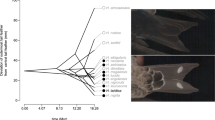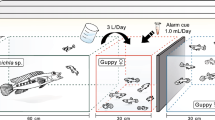Abstract
Predation risk is one of the major forces affecting phenotypic variation among and within animal populations. While fixed anti-predator morphologies are favoured when predation level is consistently high, plastic morphological responses are advantageous when predation risk is changing temporarily, spatially, or qualitatively. Three-spined sticklebacks (Gasterosteus aculeatus) are well known for their substantial variability in morphology, including defensive traits. Part of this variation might be due to phenotypic plasticity. However, little is known about sticklebacks’ plastic ability to react morphologically to changing risks of predation and about the proximate cues involved. Using a split-clutch design we show that odour of a predatory fish induces morphological changes in sticklebacks. Under predation risk, i.e., when exposed to odour of a predator, fish grew faster and developed a different morphology, compared to fish reared under low predation risk, i.e., exposed to odour of a non-predatory fish, or in a fish-free environment. However, fast growing comes at cost of increased body asymmetries suggesting developmental constraints. The results indicate that sticklebacks are able to distinguish between predatory and non-predatory fishes by olfactory cues alone. As fishes were fed on invertebrates, this reaction was not induced by chemical cues of digested conspecifics, but rather by predator cues themselves. Further, the results show that variation in body morphology in sticklebacks has not only a strong genetical component, but is also based on plastic responses to different environments, in our case different predation pressures, thus opening new questions for this model species in ecology and evolution.





Similar content being viewed by others
References
Abramoff MD, Magelhaes PJ, Ram SJ (2004) Image processing with ImageJ. Biophotonics Int 11:36–42
Andersson J, Johansson F, Söderlund T (2006) Interactions between predator- and diet-induced phenotypic changes in body shape of crucian carp. Proc R Soc Lond B 273:431–437
Bell MA, Foster SA (1994) The evolutionary biology of the threespine stickleback. Oxford University Press, Oxford
Bolger T, Connolly PL (1989) The selection of suitable indices for the measurement and analysis of fish condition. J Fish Biol 34:171–182
Bolnick DI, Lau OL (2008) Predictable patterns of disruptive selection in stickleback in postglacial lakes. Am Nat 172:1–11
Bookstein FL (1989) Principal warps—thin-plate splines and the decomposition of deformations. IEEE Trans Pattern Anal Mach Intell 11:567–585
Borg B, Bornestaf C, Hellqvist A, Schmitz M, Mayer I (2004) Mechanisms in the photoperiodic control of reproduction in the stickleback. Behaviour 141:1521–1530
Brönmark C, Miner JG (1992) Predator-induced phenotypical change in body morphology in crucian carp. Science 258:1348–1350
Brönmark C, Pettersson LB (1994) Chemical cues from piscivores induce a change in morphology in crucian carps. Oikos 70:396–402
Chivers DP, Zhao XO, Ferrari MCO (2007) Linking morphological and behavioural defences: prey fish detect the morphology of conspecifics in the odour signature of their predators. Ethology 113:733–739
Chivers DP, Zhao XX, Brown GE, Marchant TA, Ferrari MCO (2008) Predator-induced changes in morphology of a prey fish: the effects of food level and temporal frequency of predation risk. Evol Ecol 22:561–574
Crispo E (2007) The Baldwin effect and genetic assimilation: revisiting two mechanisms of evolutionary change mediated by phenotypic plasticity. Evolution 61:2469–2479
Day T, Pritchard J, Schluter D (1994) A comparison of two sticklebacks. Evolution 48:1723–1734
DeWitt TJ, Sih A, Wilson DS (1998) Costs and limits of phenotypic plasticity. Trends Ecol Evol 13:77–81
Dieckmann U, Doebeli M, Metz JAJ, Tautz D (2004) Adaptive speciation. Cambridge University Press, Cambridge
Dingemanse NJ, van der Plas F, Wright J, Reale D, Schrama M, Roff DA, van der Zee E, Barber I (2009) Individual experience and evolutionary history of predation affect expression of heritable variation in fish personality and morphology. Proc R Soc Lond B 276:1285–1293
Domenici P, Turesson H, Brodersen J, Brönmark C (2008) Predator-induced morphology enhances escape locomotion in crucian carp. Proc R Soc Lond B 275:195–201
Endler JA (1995) Multiple-trait coevolution and environmental gradients in guppies. Trends Ecol Evol 10:22–29
Engqvist L (2005) The mistreatment of covariate interaction terms in linear model analyses of behavioural and evolutionary ecology studies. Anim Behav 70:967–971
Frommen JG, Luz C, Mazzi D, Bakker TCM (2008) Inbreeding depression affects fertilization success and survival but not breeding coloration in threespine sticklebacks. Behaviour 145:425–441
Gavrilets S (2004) Fitness landscapes and the origin of species. Princeton University Press, Princeton
Gross HP (1976) Natural selection by predators on the defensive apparatus of three-spined stickleback, Gasterostrus aculeatus L. Can J Zool 56:398–413
Hammer Ø, Harper DAT, Ryan PD (2001) PAST: paleontological statistics software package for education and data analysis. Palaeontol Electronica 4:9 pp
Harvell CD (1990) The ecology and evolution of inducible defenses. Q Rev Biol 65:323–340
Heckel G, Zbinden M, Mazzi D, Kohler A, Reckeweg G, Bakker TCM, Largiadèr CR (2002) Microsatellite markers for the three-spined stickleback (Gasterosteus aculeatus L.) and their applicability in a freshwater and an anadromous population. Conserv Genet 3:79–81
Hendry AP, Bolnick DI, Berner D, Peichel CL (2009) Along the speciation continuum in sticklebacks. J Fish Biol 75:2000–2036
Hettyey A, Zsarnóczai S, Vincze K, Hoi H, Laurila A (2010) Interactions between the information content of different chemical cues affect induced defences in tadpoles. Oikos 119:1814–1822
Holopainen IJ, Aho J, Vornanen M, Huuskonen H (1997) Phenotypic plasticity and predator effects on morphology and physiology of crucian carp in nature and in the laboratory. J Fish Biol 50:781–798
Hoogland R, Morris D, Tinbergen N (1956) The spines of sticklebacks (Gasterosteus and Pygosteus) as means of defence against predators (Perca and Esox). Behaviour 10:205–236
Horppila J, Nurminen L (2009) Food niche segregation between two herbivorous cyprinid species in a turbid lake. J Fish Biol 75:1230–1243
Ihaka R, Gentleman R (1996) R: a language for data analysis and graphics. J Comput Graph Stat 5:299–314
Januszkiewicz AJ, Robinson BW (2007) Divergent walleye (Sander vitreus)-mediated inducible defenses in the centrarchid pumpkinseed sunfish (Lepomis gibbosus). Biol J Linn Soc 90:25–36
Kemper JH (1995) Role of the three-spined stickleback Gasterosteus aculeatus L. in the food ecology of the spoonbill Platalea leucorodia. Behaviour 132:1285–1299
Kusch RC, Mirza RS, Chivers DP (2004) Making sense of predator scents: investigating the sophistication of predator assessment abilities of fathead minnows. Behav Ecol Sociobiol 55:551–555
Langerhans RB, Layman CA, Shokrollahi AM, DeWitt TJ (2004) Predator-driven phenotypic diversification in Gambusia affinis. Evolution 58:2305–2318
Lass S, Spaak P (2003) Chemically induced anti-predator defences in plankton: a review. Hydrobiologia 491:221–239
Mannki J, Vauras J (1974) Littoral fish populations after an oil tanker disaster in the Finnish SW archipelago. Ann Zool Fenn 11:120–136
Marchinko KB (2009) Predation’s role in repeated phenotypic and genetic divergence of armor in threespine stickleback. Evolution 63:127–138
Mazzi D, Künzler R, Bakker TCM (2003) Female preference for symmetry in computer-animated three-spined sticklebacks, Gasterosteus aculeatus. Behav Ecol Sociobiol 54:156–161
McCollum SA, VanBuskirk J (1996) Costs and benefits of a predator-induced polyphenism in the gray treefrog Hyla chrysoscelis. Evolution 50:583–593
McKinnon JS, Rundle HD (2002) Speciation in nature: the threespine stickleback model systems. Trends Ecol Evol 17:480–488
McKinnon JS, Mori S, Blackman BK, David L, Kingsley DM, Jamieson L, Chou J, Schluter D (2004) Evidence for ecology’s role in speciation. Nature 429:294–298
Miner BG, Sultan SE, Morgan SG, Padilla DK, Relyea RA (2005) Ecological consequences of phenotypic plasticity. Trends Ecol Evol 20:685–692
Møller AP, Swaddle JP (1997) Asymmetry, developmental stability, and evolution. Oxford University Press, Oxford
Nilsson PA, Brönmark C, Pettersson LB (1995) Benefits of a predator-induced morphology in crucian carp. Oecologia 104:291–296
Nosil P, Crespi BJ (2006) Experimental evidence that predation promotes divergence in adaptive radiation. Proc Natl Acad Sci USA 103:9090–9095
Parsons PA (1990) Fluctuating asymmetry—an epigenetic measure of stress. Biol Rev Camb Philos Soc 65:131–145
Peichel CL, Nereng KS, Ohgi KA, Cole BLE, Colosimo PF, Buerkle CA, Schluter D, Kingsley DM (2001) The genetic architecture of divergence between threespine stickleback species. Nature 414:901–905
Pettersson LB, Brönmark C (1997) Density-dependent costs of an inducible morphological defense in crucian carp. Ecology 78:1805–1815
Pettersson LB, Brönmark C (1999) Energetic consequences of an inducible morphological defence in crucian carp. Oecologia 121:12–18
Pfennig DW, Wund MA, Snell-Rood EC, Cruickshank T, Schlichting CD, Moczek AP (2010) Phenotypic plasticity’s impacts on diversification and speciation. Trends Ecol Evol 25:459–467
Pigliucci M (2001) Phenotypic plasticity: beyond nature and nurture. Johns Hopkins University Press, Baltimore
Pinheiro JC, Bates DM (2000) Mixed effects models in S and S-plus. Springer, New York
Price TD, Qvarnström A, Irwin DE (2003) The role of phenotypic plasticity in driving genetic evolution. Proc R Soc Lond B 270:1433–1440
Reimchen TE (1980) Spine deficiency and polymorphism in a population of Gasterosteus aculeatus: an adaption to predators? Can J Zool 58:1232–1244
Reimchen TE (2000) Predator handling failures of lateral plate morphs in Gasterosteus aculeatus: functional implications for the ancestral plate condition. Behaviour 137:1081–1096
Reimchen TE, Bergstrom CA (2009) The ecology of asymmetry in stickleback defense structures. Evolution 63:115–126
Relyea RA (2001) Morphological and behavioral plasticity of larval anurans in response to different predators. Ecology 82:523–540
Relyea RA (2002a) Competitor-induced plasticity in tadpoles: consequences, cues, and connections to predator-induced plasticity. Ecol Monogr 72:523–540
Relyea RA (2002b) Costs of phenotypic plasticity. Am Nat 159:272–282
Relyea RA (2007) Getting out alive: how predators affect the decision to metamorphose. Oecologia 152:389–400
Reusch TBH, Wegner KM, Kalbe M (2001) Rapid genetic divergence in postglacial populations of threespine stickleback (Gasterosteus aculeatus): the role of habitat type, drainage and geographical proximity. Mol Ecol 10:2435–2445
Rohlf FJ (2003) TpsDig, digitize landmarks and outlines, version 1.39. Department of Ecology and Evolution, State University of New York at Stony Brook, New York
Scheiner SM (1993) Genetics and evolution of phenotypic plasticity. Ann Rev Ecol Syst 24:35–68
Schlichting CD, Pigliucci M (1998) Phenotypic evolution: a reaction norm perspective. Sinauer, Sunderland
Schluter D (2000) The ecology of adaptive radiation. Oxford University Press, Oxford
Sheets HD (2002) IMP-integrated morphometrics package. Canisius College, Buffalo, Department of Physics, New York
Sibbing FA, Nagelkerke LAJ (2001) Resource partitioning by Lake Tana barbs predicted from fish morphometrics and prey characteristics. Rev Fish Biol Fish 10:393–437
Sokal RR, Rohlf FJ (1995) Biometry, 3rd edn. W. H. Freeman & Company, New York
Stabell OB, Lwin MS (1997) Predator-induced phenotypic changes in crucian carp are caused by chemical signals from conspecifics. Environ Biol Fish 49:145–149
Tollrian R, Harvell CD (1999) The ecology and evolution of inducible defenses. Princeton University Press, Princeton
Waddington CH (1942) The epigenotype. Endeavour 1:18–20
Webb PW (1984) Body form, locomotion and foraging in aquatic vertebrates. Am Zool 24:107–120
West-Eberhard MJ (1989) Phenotypic plasticity and the origins of diversity. Ann Rev Ecol Evol Syst 20:249–278
Wisenden BD, Chivers DP (2006) The role of public chemical information in antipredator behaviour. In: Ladich F, Collins SP, Moller P, Kapoor BG (eds) Communication in fishes. Science Publisher, Enfield, pp 259–278
Wund MA, Baker JA, Clancy B, Golub JL, Foster SA (2008) A test of the “flexible stem” model of evolution: ancestral plasticity, genetic accommodation, and morphological divergence in the threespine stickleback radiation. Am Nat 172:449–462
Zelditch ML, Swiderski DL, Sheets HD, Fink WL (2004) Geometric morphometrics for biologists. Academic Press, London
Acknowledgments
We are grateful to Jan Hottentot, Jörg Freyhof and Peter Beeck for catching and Julia Böhm for caring for the fish. We thank Ricarda Modarressie, Ingolf Rick, Jobst Pfaender and Paul Alibert for discussion. An earlier version of the manuscript was greatly improved by the comments of Valentina Balzarini and two anonymous referees.
Author information
Authors and Affiliations
Corresponding author
Rights and permissions
About this article
Cite this article
Frommen, J.G., Herder, F., Engqvist, L. et al. Costly plastic morphological responses to predator specific odour cues in three-spined sticklebacks (Gasterosteus aculeatus). Evol Ecol 25, 641–656 (2011). https://doi.org/10.1007/s10682-010-9454-6
Received:
Accepted:
Published:
Issue Date:
DOI: https://doi.org/10.1007/s10682-010-9454-6




